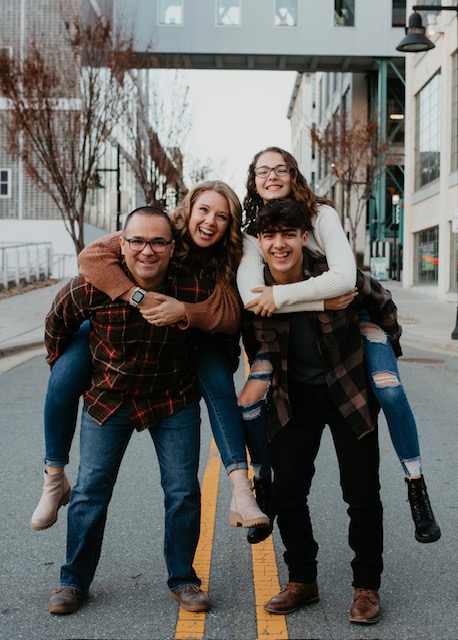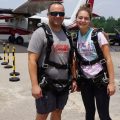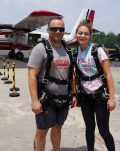My journey with IIH started in the fall of 2022 when I started having right scapular pain. This would often then progress to pulsatile tinnitusA whooshing or throbbing noise heard in one or both ears that can range from annoying to debilitating. Highly associated with venous sinus stenosis. Click the term to read more, blurry vision, and a pressure-like headache. If symptoms progressed, I’d start to feel as though I was going to pass out, though I have never fully passed out. During my worst episodes, I would lose fine motor skills with my right hand, I’d experience involuntary movements with my right arm and legs, and the inability to form words. The progression of these symptoms were progressive over time and within six months, these episodes were getting more frequent and more predictable.
My story is one of self advocacy and the need for family support. In early 2023, my symptoms led me to a chiropractor and then to my PCP. My initial imaging included a non-contrast MRI of my entire spine and my head. I was referred to neurology and a possible Chiari I malformation was noted by my initial neurologistMedical doctor who diagnoses and treats nonsurgical issues related to the brain and nervous system. Click the term to read more. As for my symptoms, he told me that I “didn’t fit in any of their boxes.” My wife remained by my side and insisted that we keep moving forward. I was referred to an adult neurosurgeonMedical doctor who diagnoses and treats surgical issues related to the brain, spine, and nervous system. Click the term to read more due to my MRI Head findings and he did not feel that surgical intervention was warranted, but referred me to a pediatric neurosurgeon for a second opinion. The second neurosurgeon agreed that nothing further needed to be done. In regards to my symptoms, neither neurosurgeon could explain what was going on with me medically. The predictable “we don’t know what is happening” was becoming what we expected to hear, but we agreed to not stop looking for answers. I was sent back to neurology and underwent further lab work, an ambulatory EEG, and nerve conduction studies, all of which were normal.
At this point, I self referred myself to one of the top three medical systems in the United States. As a nurse practitioner, I could see that whatever was going on with me was not going to be found at a private healthcare system and that I needed to go to a more researched based organization. I met with my neurologist to review all of my findings before being seen at the research based healthcare system and was told that there was nothing wrong with me and that I needed to be prepared to hear that at my upcoming appointment. I was demeaned and humiliated by this neurologist who worked for the same organization as me. Still, we were not going to give up and we kept our plan to be seen elsewhere.
We sought our second opinion at the new hospital system and I was given a rather subjective diagnosis and sent on my way. No further imaging or testing was done and PT was the only recommendation. We felt some hope, but something was missing. There was no objective way to prove what my actual diagnosis was. The weeks went by and a friend of mine that is an anesthesiologist was not convinced with my new diagnosis. He felt that I needed to be seen at our local research based health system and that I needed to see neurosurgery in particular. Again, I self referred myself and was scheduled to see one of their NP’s. The night before my appointment, I messaged her a one-paged, very condensed version of my story, symptoms, testing, and results.
We sat in the exam room preconditioned to hear another “we don’t know what is happening.” But, after approaching two years of searching, the NP immediately let us know that she was pretty confident that I had IIH. Prior to our appointment, she reviewed my one page “review” and took it to their IIH team. The NP and neurosurgeon on the IIH team felt that my story was definitely suspicious for IIH. CT with contrast of my head and neck were ordered and multiple areas of stenosis were found that would contribute to an IIH diagnosis. We met with our IIH neurosurgeon and his team the following week and knew that we were finally in the right place. In the coming weeks, I underwent dynamic testing that showed that I had significantly elevated pressures, as well as elevated opening pressure with my lumbar punctureA procedure where a needle is placed in the lower part of the spine (the lumbar spine) to access cerebrospinal fluid. Click the term to read more.
Procedure day arrived and it was full of emotions. Crying as we headed down the highway to the hospital in the early morning hours was inevitable as we tried to process the past two years of unknowns and now the unknowns of what would lie ahead with the new rare disease diagnosis, but we were confident that we were on the right path. I had 3 stents placed in my superior sagittal sinus that morning and was home later that day. After the initial recovery, my symptoms started to greatly improve and I felt so much better. It was around 2-3 months after my procedure that my symptoms started coming back, which was expected due to two other areas of concern; my right and left jugular veins. Nearly four months after my initial procedure, we met with my neurosurgeon and formed a plan to proceed with stenting of my lower left internal jugular vein. This has slowed the progression of my symptoms and we will be discussing our plan for my right jugular in the comings weeks. Due to a very thorough diagnostic work up early on, we know that there are areas of concern within that vessel.
As a nurse practitioner, I have insight into the healthcare system that many people do not. Many don’t know how to be persistent in advocating for themselves and who they need to keep voicing their concerns to. With the amazing support of my wife, my two children, and our extended community, we were able to keep pushing forward. We always sought out the advice of those within the medical community that we knew personally and tried to learn whatever we could so that we were as prepared and as educated as possible. Throughout it all, I never missed work in a busy cardiology office (except for appointments and procedures), and we continued to attend Crossfit 3-4 times per week. My instincts told me that I had to keep pushing and that I had to keep my body as active as possible because I didn’t know where all of this was leading.
Since being diagnosed with IIH, learning so much about it, and experiencing life with the diagnosis, we have been able to come along nearly a half dozen other individuals with the same diagnosis and help them better understand it, help them learn how to advocateTo self-advocate in your health is to communicate your needs Click the term to read more for themselves, encourage them to remain active, and provide general support with day to day questions that come up within their own journey.


